VOL. 32, #4, Winter 2014
Model Gem Portfolios: 1985 vs. 2015 Models, Latest Gemstone News, Gem Investment News, Gem News, Gem Robberies, Notable Quote, Victoria's Secret Bras
- Home
- Newsletter
- VOL. 32, #4, Winter 2014
Model Gem Portfolios: 1985 vs. 2015 Models, Latest Gemstone News, Gem Investment News, Gem News, Gem Robberies, Notable Quote, Victoria's Secret Bras
Model Gem Portfolios: 1985 vs. 2015 Models
by Robert Genis
It's been 30 years since we first published our model portfolios in the newsletter. As in any market, things change. We decided to update these three model portfolios to reflect our current thinking regarding the gemstone markets.
High End
We are adding Burmese Jade to the High End Portfolio, even though they are embargoed. These gems have skyrocketed with the rising Chinese market. Of course, in 1985, Pariaba tourmaline had not been discovered.
We also moved Burma ruby from the Middle to the Top Portfolio, even though those stones are embargoed also. Burma sapphire moves up because it belongs right next to Kashmir in the high end. We are also adding the comment of no treatment to Colombian emeralds, because it's a necessity for a collector.
We are moving demantoid garnets down to middle because recent finds in African and Russia have kept this stone more available than we like. We still believe everyone should own one. We have added pink diamonds with blue diamonds. Can you imagine what a blue diamond is worth today vs 1985?
Black opal was dropped from the list due to their fragility. Chrysoberyl Cats-Eye has been dropped. We love these stones but few people request them and they are difficult to find.
Middle End Portfolio
We are adding Nigerian tourmaline because some of these goods offer a Paraiba look for a fraction of the price. Color-Change garnets were added because they became more available from Africa. Same for Burmese spinel, the gem dealer's favorite stone. Tanzanite was dropped from the portfolio, due to its decades long price weakness.
Low End
We have added Fancy Sapphires and Fancy spinels because many collectors want no treatment Burma goods but have limited budgets. Although our favorite Namibian Mandarin mine is closed, you can still pick up some other orange garnets inexpensively. We also like Brazilian rubelite although it's becoming hard to obtain.
Summary
Collecting gems is fascinating. No matter what type of collector you are simply buy what you love. Yes, and never forget - have fun!
|
|
Pink Diamonds
The 30th Rio Tinto Australian pink diamond tender included 54 diamonds The sales results are confidential but Rio Tinto said the diamonds attracted the highest per carat price ever. These pinks sold for 3x the per carat price in 2000.
Red Diamond
Christie's Hong Kong sold a 2.09 red diamond for over $5 million or $2.44 million per carat.
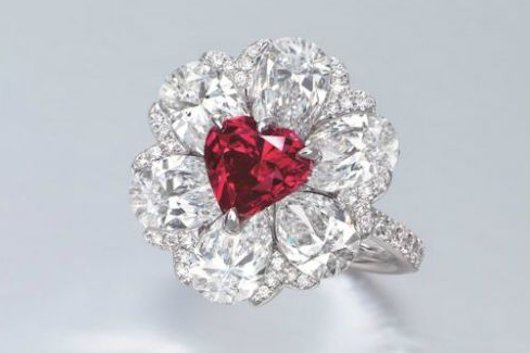 |
Burma Ruby
London jeweler Laurence Graff bought back The Graff Ruby for a second time. He first bought the 8.62 unheated stoplight red, Burma ruby for $3.62 million or $420,000 per carat in 2006. He sold the stone to Greek financier Dimitri Mavromattis. The stone became available again at Sotheby's, November, 2014. He paid $8.6 million or almost a million dollars per carat, These goods are now reaching colored diamond prices.
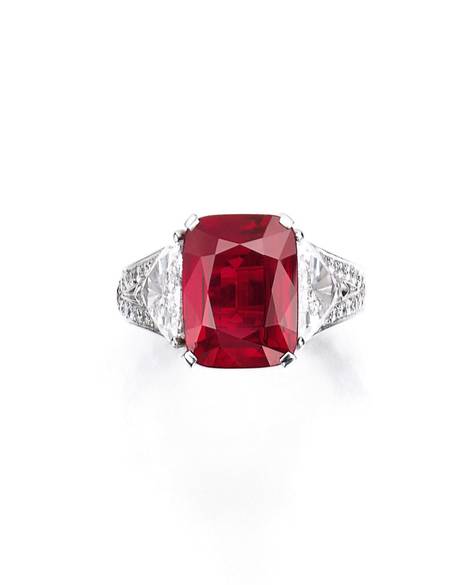 |
Burma Sapphire
An unheated 41.54 Burmese sapphire sold for $1,625,200 or $39,000 per carat at Christie's London. It was bought by a Swiss Jeweler at triple the reserve.
Ceylon Sapphire
A 392.52 carat Ceylon sapphire sold for $17.3 million or $440,000 per carat at Christie's in November, 2014. It's the world's forth largest sapphire and was sold to a private collector sitting in the audience. The stone was rumored to once be a present for the Queen Mother.
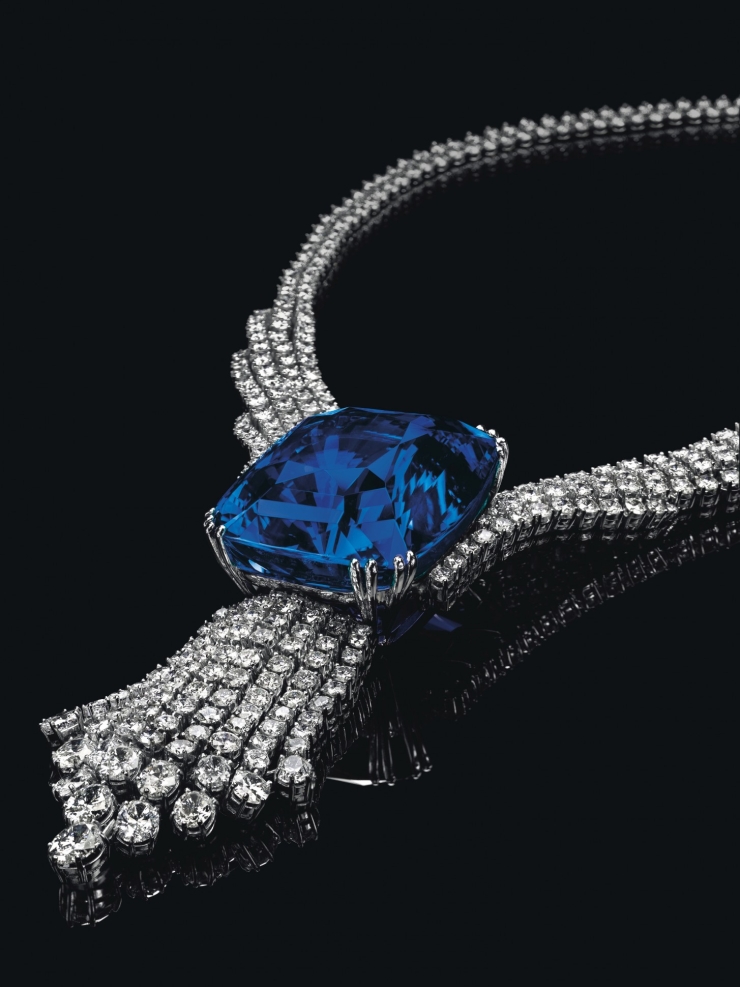 |
Kashmir Sapphires
At Sotheby's Geneva, a 27.54 Kashmir sold for almost $6 million or $217,000 per carat. This is a world record for a Kashmir. A 14.66 Kashmir sapphire circa 1890, sold to the international trade for $2,197,044 or $149,000 per carat at Christies London in November.
Christie's also sold an 8.91 Kashmir sapphire for $1,370,500 or $154,000 per carat.
A 3.20 Kashmir sapphire sold for $118,750 or over $37,000 per carat at Bonham's Fine Jewelry in New York.
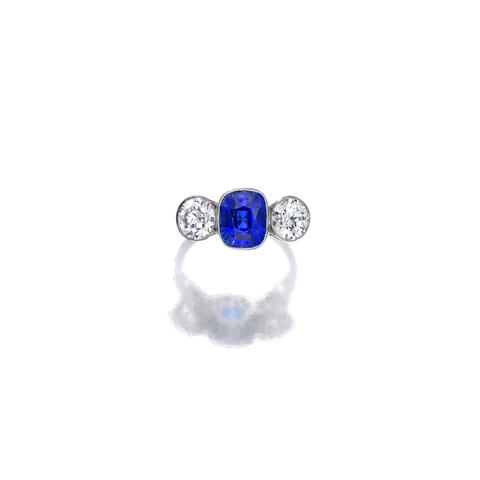 |
This is an interesting article from an Indian perspective. It contains a great deal of vital information but has a major error. The article states emeralds come at the top of the colored stone prices, followed by sapphires and then rubies. Not accurate and totally backwards. Rubies are the most expensive colored stone, followed by emerald and sapphire is last. You could even argue sapphire is second if you count Burma and Kashmir sapphires.ED
Gem of an investment
Hindu Business Line
By Bhavana Acharya
October 12, 2014
If you are looking for high returns, don't stop with diamonds. Gemstone prices too have appreciated in recent times.
A flash of red. A burst of green. A shimmer of blue. The trinity of precious gems - rubies, emeralds, and sapphires - don't have the white brilliance of diamonds. But they are slowly chipping away at the diamond's bastion. Affluent investors are shifting to colored gems that have a character of their own.
If you can squirrel away diamonds as long-term investments, can you do the same with the Big Three of gemstones? It would seem so. The GemVal Aggregate Index, which represents prices of 26 gemstones, has risen by around 47 per cent in the past five years.
Idiosyncrasies abound
But gemstones have a unique set of idiosyncrasies, of which quirky pricing is the biggest. If you can safely navigate the minefield that is gemstone pricing, appreciation in price may be quite handsome in the long term.
The precious gem trinity, like diamonds, depends on the 4Cs - the stone's cut, its clarity or freedom from impurities (flaws or inclusions), its color or hue, and its carat (weight). But while diamonds have a clear grading system, colored gemstones don't. That's the first reason why there's no standardized pricing for gemstones.
The second pertains to the 'inclusions' or imperfections in each stone. It is near-impossible to get an absolutely flawless colored stone. Top-quality stones usually have slight inclusions. Flaws can also, at times, even enhance gem values depending on the type of flaw. A star-patterned inclusion in a ruby or sapphire is rare, for example.
Gemstones can be treated to address these imperfections, usually through heat or by coating with oils and polymer compounds, which take away from the ‘natural' element. So an untreated gem commands a premium over a treated one.
The third uncertainty pertains to the color. Not all red stones are rubies; and all green ones are not emeralds. A stone with a deeper, richer, or more brilliant hue is pricier. A certain level of color saturation must be met for classification into gem types. For example, ruby and sapphires are both varieties of the mineral - corundum. But a pink-toned ruby is actually not a ruby. It can sometimes turn into a (pricier) pink sapphire. A lighter-toned emerald is a green beryl, which is both cheaper and more common.
The fourth problem point is the mine from which the stone originated, which can sometimes influence prices. Certain mines generate better-quality stones. Kashmir sapphires are extremely rare and expensive. Rubies from Burmese mines are also rare. Sri Lankan sapphires command premiums.
Then Indian market has its own peculiarities. Loose stones are popular in the Indian market but their demand is driven mainly by astrological and religious beliefs, says Haresh Soni, Chairman, Gems & Jewelry Trade Federation. For this reason, he says, one cannot take a price gain for granted, even though there is a resale market for gemstones. Further, as stones such as emeralds are softer, scratches or breaks can lower the value.
In a nutshell, valuing a gemstone as one would gold, or even a diamond, is complicated. A lot also depends on subjective evaluation by the individual jeweler on all the Cs (except carat).
Demand rise
But if you have a love for gemstones and are willing to wait it out, it would gladden you to know that precious stone prices are generally moving northwards.
As a thumb rule, emeralds come at the top of the colored stones pecking order, followed by sapphires and then rubies. But market fancies can take some gemstones up and others down. Going by the GemVal index for the gem, ruby prices have almost doubled in the past ten years. Demand for fine-quality gems is countered by very scarce supply. Sapphire prices are up about 65 per cent. Rise in emerald prices has been more modest, with the representative GemVal index up 24 per cent in the past five years. Gemstone demand has taken the route most luxury goods have in the past few years - corrected in 2008 and 2009 before moving up in the past two years - especially for fine-quality stones. But buying of low-quality gemstones was maintained throughout.
Improved consumer confidence in the key US market led the bounce-back, and can sustain price trends. Demand has also been growing across markets - Japan, the Gulf countries, Europe, China and India. In dollar value terms, global import of rough emeralds, rubies, and sapphires were up 21 per cent in 2013, better than the 13 per cent growth the year before, going by UN Comtrade data. Next, efforts are on to organize the market and drive demand for colored gemstones just as DeBeers did for diamonds.
For the investment-oriented, it is best to buy loose gemstones. Buying at the cheaper wholesale level will also improve returns. Insist on certification from independent gemologist labs on the genuineness of the stone and also on whether it has been treated. Indian Gemological Laboratory, IGI India, Gemological Institute of India, are some of the labs that issue gemstone certifications.
Supply is scarce
Supply is the other side of the equation that drives prices. Unlike diamonds, colored stone mining is not concentrated in the hands of a few; so it becomes harder to control supply and influence prices. Among colored gemstone miners, Gemfields Plc. is the largest.
The company accounts for about 25 per cent of the global emerald output, says Rupak Sen, Regional Marketing Director-Asia, Gemfields. Annual production in the past three years has been 20-30 million carats, according to the company's reports, and is likely to continue along similar lines. Price movement for emeralds will, therefore, depend more on how demand pans out.
Supply of rubies received a boost this year with production starting from Gemfields' mine in Mozambique - probably the world's single largest ruby mine, says Sen. Eventually, its share in total ruby production could reach 25-30 per cent. Burmese-origin rubies may add to supply if current embargoes are lifted. But this is uncertain, and given the rising demand for quality gems, ruby prices are unlikely to dip even with a production increase. High-quality sapphires are scarce too, concentrated in Sri Lanka and Burma, which can support prices.
Brilliant rocks
A storied gem, a rich history and rarity are the perfect mix for record auction prices. In April this year, auction house Sotheby's auctioned off a ring for almost $5.1 million. The reason? The ring held a square emerald-cut Kashmir sapphire weighing 28.18 carats, among the finest sapphires ever to appear at an auction.
Also in April, Sotheby's auctioned the Hutton-Mdivani Necklace, the greatest jadeite bead necklace in the world. It set a record auction price for any jadeite jewelry, fetching a thrilling $27.44 million.
A 29.62-carat cushion-shaped oval Burmese Mogok ruby and diamond ring was auctioned off by Sotheby's for $7.34 million, the highest for a ruby. The world record auction price for a ruby necklace was set by a Burmese ruby and diamond necklace. In November 2013, Christie's auctioned the 87.78 carat necklace for $6.42 million.
In December 2011, the auction of The Collection of Elizabeth Taylor by Christie's totaled $156.8 million, the highest for a private jewelry collection.
Gem News
Asian buyers want more than just diamonds
CNBC.com
by See Kit Tang
October 8, 2014
Dubbed the "World's most sought after" emerald jewelry, the "Grand Esmeralda Suite" - a 30-carat necklace and earrings set featuring 7 unoiled deep green gems - is making its first Asia appearance at a jewelry show in Singapore.Created by Switzerland-based luxury jeweler Mouawad, the exquisite piece with a $14.5 million price tag aims to capture shifting demand for high-end jewelry in Asia.
"Things have shifted from the old days when everything was about white diamonds. Nowadays, people are interested in investing in colored stones," said Jean Nasr, managing director at Mouawad Singapore, referring to precious stones like rubies, sapphires and emeralds. "There's a sense of competition and it's also about making a statement. Women of today are also very confident and they want to show that they dare to be different."
Growing demand boosted prices of colored stones by 30-60 percent over the past six years, Angela Loh-Bém, festival director of Singapore JewelFest, an annual high-end jewelry show, told CNBC.
Rare colored gems such as Tanzanite and Paraiba Tourmaline are also gaining traction among Asia's jewelry buyers, she said. The former is an increasingly rare stone available only in the depleting mines of Tanzania, while the latter changes into a brighter shade of blue under heat.
"Asians are now looking for things that are hard to come by. The bottom-line is rarity that they can afford," said Loh-Bém.and try again.
Changing demand
Increasing affluence in Asia and consumers' ability to research purchases on the internet underlie the shift in preferences, industry watchers say.
Southeast Asian consumers are one of the most educated buyers in the region, according to Loh-Bém: "There are many educated shoppers right now who know exactly which gem stone they want and how much they should buy it for."
"Two years back at the Singapore JewelFest, there was a gentleman who came looking for a 13-carat aquamarine," she said. "That is very specific and he's a man!
Demand for Objet d'art - jewelry that resembles art pieces - and innovative pieces is also increasing, according to industry watchers.
German jewelry maker Heinz-Mayer, for instance, received positive responses from Asian buyers between the ages of 35 to 50 years old for its "Rolling Diamonds Bracelet", which it will exhibit in Singapore.
"Asian consumers are learning quickly. They have become more educated but continue to demand only the best. The more educated consumers are open to moving away from brand names as they discover lesser-known, more exclusive hidden champion brands," a Heinz-Mayer representative told CNBC via email.
Not worried about China
China's economy is slowing as Beijing re-balances toward consumption-led growth, while an anti-graft campaign continues to limit luxury spending, but some jewelers are not worried about demand in Asia's largest jewelry market.
"China has been consistently improving. Lately there's been a slowdown which has affected some in the country but that said, we still have the middle income range that are becoming more affluent," said Mouawad's Nasr.
Jewelry sales in China totaled $75.8 billion in 2013, roughly 42 percent of global consumption, according to a report by Research and Markets.
"India used to only invest in gold but now it's changing, they are spending more money on diamonds and colored stones," Nasr added. "We also have customers from Myanmar, Indonesia and different parts of the region that are still spending, so you win some you lose some."
David Ortiz says jeweler sold him imitation diamonds
Globe Staff
By Evan Allen and Peter Araham
November 05, 2014
It should be common knowledge, don't mess with Big Papi. ED
He can tell the difference between a 98-mile-per-hour fastball and a devastating splitter in a fraction of a second. But Red Sox slugger David Ortiz is alleging that a California jeweler was able to slip a change-up past his discerning eye. Ortiz is suing the jeweler, claiming he sold Ortiz fake or low-quality diamond and gold jewelry for $127,000, and then failed to refund the money when Ortiz discovered the deception.
Ortiz, who like many prominent athletes wears expensive jewelry and accessories, is accusing Randy Hamida of Anaheim, Calif., as well as Randy's Mens Wear, Ltd. Inc., of fraud, breach of contract, and other violations stemming from a 2010 purchase. The man known as Big Papi thought he had bought a Breitling watch with diamonds and white and yellow gold, a diamond bracelet, and a set of black diamond earrings, a necklace, and a bracelet, according to a civil suit filed in Middlesex Superior Court on Thursday .But when Ortiz had the jewelry appraised, he found it was "imitation or low-quality metal and gemstones," the suit alleges.
"David doesn't buy jewelry, or buy anything, from just anybody. And he trusted Mr. Hamida," said Jonathan M. Davidoff, Ortiz's lawyer. "This was a last resort for David. David didn't want to sue. But also, David doesn't want to be taken advantage of. And professional athletes are targets, unfortunately."
The suit says that Hamida presents himself as a luxury jewelry dealer who targets professional athletes, and "travels nationwide to Major League Baseball cities to stalk players at their hotels in an attempt to peddle his jewelry."
Ortiz bought the jewelry in 2010, after Hamida had pursued him for years in an effort to "lure" him into purchasing jewelry, the lawsuit says.
In a brief phone interview, Ortiz, whose collection of ear studs, necklaces, and bracelets is ever-changing, brushed off this bauble dispute as he might an offspeed pitch that plunked him on the shoulder.
"It's going to get taken care of; I'm not worried," Ortiz said, adding that he is not getting personally involved in the suit.
No attorney is listed on court documents as representing Hamida, who also goes by the last name "Hamideh." Calls to phone numbers listed to his name and address went unreturned Tuesday.
According to the suit, Hamida approached Ortiz in September 2010 at the Red Sox' team hotel in Seattle, and Ortiz asked Hamida to meet him in Massachusetts at the end of the season. The two met in October, and Hamida presented Ortiz with "allegedly custom-designed jewelry of the highest quality gold, diamonds, and other precious gemstones," according to the suit. Ortiz paid with a check for $80,000 and about $47,000 worth of his own jewelry.
After Ortiz discovered the jewelry was not worth what he paid, Hamida initially attempted to avoid Ortiz, according to the suit, but ultimately met with him in April 2011 when the Red Sox traveled to Anaheim.
"Hamida acknowledged to Ortiz that the jewelry was of a lesser value than he represented, and promised a full refund and a return of Ortiz's necklace," according to the suit.
But Hamida failed to pay, according to the suit. When Ortiz confronted him about it, Hamida again apologized and promised to pay, but said he needed until the end of 2011 because of financial problems, according to the suit.
Hamida asked Ortiz to return the jewelry so he could sell it to raise the money to repay Ortiz the $80,000, according to the suit. Hamida told Ortiz he would return the slugger's necklace the next time Hamida saw him, the lawsuit says.
At the end of 2011, Ortiz agreed to return the jewelry to Hamida in exchange for the promise of his necklace and money back, but Hamida has still not paid, according to the suit. It says Ortiz has learned from other players that Hamida "has a history of conducting himself in this manner."
Hamida used Randy's Mens Wear, a company owned by his father, to collect payments made to him in credit cards or checks, according to the suit. The California Secretary of State's website lists the company as "suspended," for "failure to meet tax requirements."
A phone call to a number listed to Hamida's father went unreturned, and no working number could be found for the company.
Davidoff said he was not aware of any other suits against Hamida, and said that before Ortiz decided to sue, he attempted to talk things out with the jeweler.
"When he realized that the jewelry was not authentic, and not what Mr. Hamida purported it to be, he very nicely said, 'Make good on it,' with the big David Ortiz smile," said Davidoff. "Mr. Hamida gave him a song and dance, and that's why this ended up in litigation."
Cartier jewelry heist in Paris sparks police chase and hostage capture
Telegraph
By AFP
Nov 26, 2014
Two men with an AK-47 robbed a Cartier jewelry store near Paris's Champs-Elysees on Tuesday, leading to a police chase and a brief hostage-taking when they sought refuge in a hair salon.
The suspects agreed to release the hostage and turn themselves in, with the entire drama lasting about two hours. Police recovered a cache of jewels the men had stolen.
One witness inside the Cartier store located in a busy touristic area said the two men, who did not seem "professional", burst in late in the day and forced the three customers inside and about 10 staff to lie down.
They then demanded that the store's showcases be opened, but were interrupted as they gathered jewelry by the sound of police sirens.
The suspects fled with the store manager. A witness told AFP he saw one of them dressed in a trench coat and a beret, with a towel on one hand and holding the hostage with the other.
"Everyone tried to hide," said the witness, who gave his name as Vincent and had been at a nearby restaurant's terrace.
The two men dropped their hostage and fled aboard a scooter while shooting into the air, but later fell and ran away on foot before entering the hair salon.
The salon manager was the only person inside and was taken hostage. Around 100 police were mobilized with the support of a helicopter.
"A negotiator was able to quickly enter into contact with them," Paris prosecutor Francois Molins said.
"They agreed somewhat quickly to free the hostage safe and sound, and they turned themselves in."
Besides the AK-47, they also had a 9mm pistol. Their stolen jewelry was recovered inside the hair salon.
"There was lots of money and jewelry that had been well-chosen," the prosecutor said.
A police officer was lightly wounded by a bullet fragment, while one of the suspects was injured in the scooter fall.
In recent years France has seen several high-profile robberies of luxury jewelry stores.
"Although the process of assessing colored stones requires an aesthetically-driven kind of expertise, it doesn't mean all gemstones are equal. Rubies, sapphires, and emeralds sourced from historically significant regions are still more desirable and continue to fetch higher prices. For centuries esteemed mines in Kashmir, Sri Lanka, and Burma have produced highly sought after corundum, the extremely durable mineral that forms rubies and sapphires. These mines are known for producing stones with deep color saturation, like prized "pigeon blood" rubies and "velvet" blue sapphires. Even though they are found on every continent, a vanishingly small percentage of colored stones on the market stand apart. Over 98% of the stones available today have been heated in an attempt to improve their natural color. Connoisseurs should look for telltale signs that the mined material remains authentic and untouched by human meddling. At first glance a high quality stone should have three things: a deep color tone, few visible inclusions, and a symmetrical faceted cut."
Katherine Palmiter
Forbes
December 3, 2014
Breaking with their pattern, Victoria's Secret created two bras this year. Each bra is $2 million, the total being down 60% from last year. Created by Mouawad, they are like an Egyptian body costume. The bras are covered with 16.000 rubies, sapphires, topaz, agates and diamonds. The combined total weight of the two bras is 9,322 carats. The bras took over 1380 hours to make in 18k gold.
So far, two bras have been sold; the Heavenly from 2004 and the Floral Fantasy Bra from 2012. If not sold in a year, they are taken apart.
Since 1996, these bras peaked in price in 2000 at $15 million. The trend has been down every year except last's year $10 million Royal Fantasy Bra. We believe this is an interesting indicator of social mood.
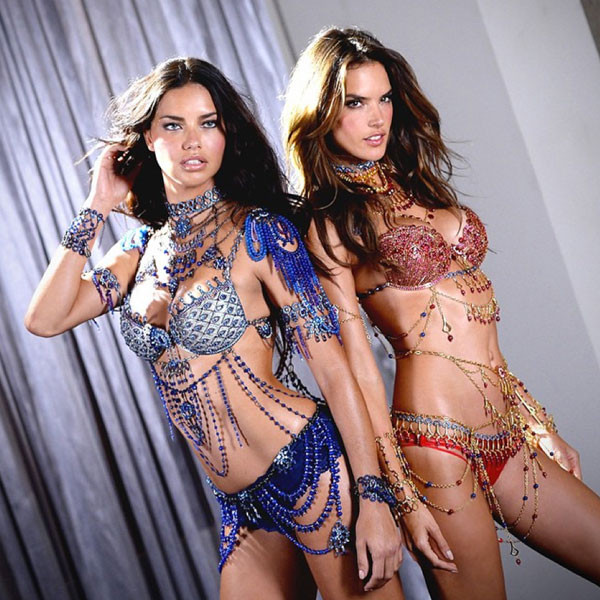 |